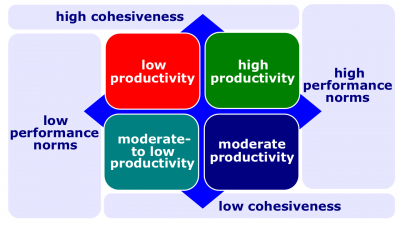Difference between revisions of "Group cohesiveness"
MariamKhalid (talk | contribs) |
|||
| Line 4: | Line 4: | ||
According to [[Organizational Behavior by Robbins and Judge (17th edition)]], | According to [[Organizational Behavior by Robbins and Judge (17th edition)]], | ||
:[[Group cohesiveness]]. The extend to which members of a group support and validate one another while at work. | :[[Group cohesiveness]]. The extend to which members of a group support and validate one another while at work. | ||
| + | According to [[Management by Robbins and Coulter (14th edition)]], | ||
| + | :[[Group cohesiveness]]. The degree to which group members are attracted to one another and share the group's goals. | ||
==Related concepts== | ==Related concepts== | ||
| Line 11: | Line 13: | ||
*[[Social Rationale Quarter]]. | *[[Social Rationale Quarter]]. | ||
| − | [[Category: Septem Artes Administrativi]][[Category: Articles]] | + | [[Category:Management]][[Category: Septem Artes Administrativi]][[Category: Articles]] |
Latest revision as of 17:39, 2 June 2020
Group cohesiveness (alternatively known as social cohesiveness, team cohesiveness, or, simply, cohesiveness; hereinafter, the Cohesiveness) is the extend to which members of a group support and validate one another, attracted and emotionally attached to one another, share the group's goals, and motivated toward the group.
Definitions
According to Organizational Behavior by Robbins and Judge (17th edition),
- Group cohesiveness. The extend to which members of a group support and validate one another while at work.
According to Management by Robbins and Coulter (14th edition),
- Group cohesiveness. The degree to which group members are attracted to one another and share the group's goals.
Related concepts
- Social norm. An acceptable standard or expectation within a group that is accepted and shared by a group's members.
